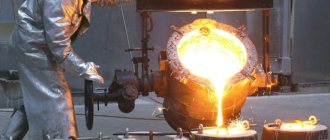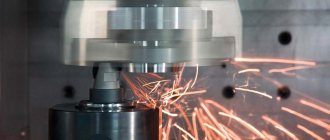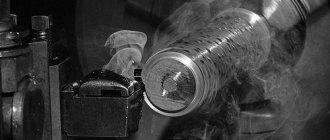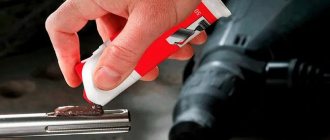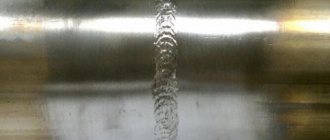Types of steel 200 series
Rolled stainless steel of this group is known under the brand name 201. AISI 201 sheet is similar in properties to the 300 and 400 series, but contains less expensive nickel and more manganese. Due to this, stainless steel 201 is cheaper than its analogues. Such a replacement does not impair its strength, ductility, or corrosion resistance.
The alloying elements here are copper, manganese, nickel, chromium, nitrogen and carbon. The Russian analogue is 12x15g9nd.
Mechanical and technological properties:
- resistance to high/low temperatures
- low corrosion rate
- resistance to mechanical damage and cracking
- suitable for forging
- welds well at temperatures up to 800 degrees
- increased plasticity allows the use of drawing and broaching technologies.
Stainless steel sheet AISI 201 is applicable:
- for the manufacture of cutlery, food industry equipment, food storage containers, water - thermoses, tanks, flasks
- in the cladding of building structures - elements of stairs, window frames
- for car parts - body trim, bumpers
Properties aisi 439 430
So, despite the fact that these grades of stainless steel belong to the same class - ferritic, chromium, corrosion-resistant and heat-resistant steel, differences in the percentage of alloying additives in the alloys greatly affect their properties, and it is necessary to use stainless steel 439 or 430 in accordance with the requirements for their operation. For example, the presence of chromium in 13% or more leads to the resistance of products in mildly aggressive environments, and over 17% in highly aggressive acids. Titanium in 439 steel provides increased strength and resistance to loads.
When choosing structures and elements for production, and making a decision - stainless steel 439 or 430, you must be guided, first of all, by the conditions of the intended operation.
Despite the fact that these steels are both heat-resistant, AISI 439 is characterized by heat resistance without loss of its properties, when used in conditions up to 850 °C. A 430 can withstand 750 °C with continuous exposure, and 850 °C with intermittent exposure (although when operating at 425-525 °C for more than 100 hours, the steel becomes brittle). The presence of aluminum in the composition gives increased resistance to high temperatures to 439 steel.
The nickel content in alloy 439 defines the steel as weakly magnetic, which is also important for the manufacture of structures. Despite the fact that 430 does not contain nickel, it is successfully replaced by manganese and nitrogen, which makes it possible to classify this alloy as austenitic, and similar in properties to steels 304, 316.
Both steels, stainless steel 430 or 439, are distinguished by their high strength and high ductility, are easily welded and formed, and are subject to bending and stamping. Structures made from them are characterized by reliability and long service life.
AISI steel 300 series
In this group, we can distinguish brands that differ in the ratio of chromium, nickel, carbon and titanium.
Depending on their composition, they are divided into austenitic-ferritic, austenitic, and austenitic-martensitic classes. This series has universal properties, therefore it is in demand in different directions.
AISI 304
This brand has been dubbed “food”, although it is used in other areas of industry no less. It has increased heat-resistant and anti-corrosion properties.
Suitable for all types of processing: welding, drawing, rolling, forging, shape molding, plasma or laser cutting.
Composition of AISI 304:
- C <0.08%
- Mn <2.0%
- P <0.045%
- S <0.03%
- Cr 18.0-20%
- Ni 8.0-10.5%
The scope of application is not limited to the food sector; durable, strong steel is made of:
- exhaust pipes
- pipe products, furnace equipment elements
- containers, vessels of the chemical, pharmaceutical industry, operating at temperatures from 200 to 650 degrees
- tanks for oil refineries
AISI 304 stainless steel can be purchased in sheet or roll form. The preferred format is determined only by the wishes of the customer; the quality of the product does not change.
Russian equivalent - steel 08x18x10
AISI 316
Stainless steel 316 is available with the addition of molybdenum. This is a chemical element that increases the material’s resistance to corrosion and resistance to elevated temperatures. Steel 316 is more expensive than AISI 304. It is actively used by shipbuilding, aviation, and oil and gas enterprises.
Analogue from Russian manufacturers - 10x17n13m2
AISI 316T
316T stainless steel is enriched with titanium, which gives the metal the ability to resist the damaging effects of chlorine. It also strengthens and improves heat-resistant characteristics. Unlike 304 grade, this one has no magnetic properties.
Main areas of use:
- production of gas turbine blades
- special equipment for chemical and pharmaceutical industries
- construction of heat exchangers of various sizes
- architectural elements
- details of roofing structures
Russian brand - 10x17n13m2t
AISI 321
An improved version of the previous type with an increased titanium content, here it contains 10%, which indicates even greater strength and hardness of this material. It is easy to weld and can withstand temperatures up to 880 degrees.
AISI 321 steel is used in:
- production of seamless pipe products
- production of flanges, transition elements
- shipbuilding, mechanical engineering
- boiler manufacturing
- construction of furnace systems
- production of heating elements
- aviation industry
Brand of Russian manufacturers - 12-08x18n10t
Choosing steel for the chimney. How not to burn out?
Most manufacturers offer dozens of different chimney designs. If you are not a specialist, it will be extremely difficult to understand their features on your own. Therefore, most often a simple choice is made between the AISI 321 steel grade, 0.5 mm thick, and the AISI 430 steel grade, 1 mm thick. Sometimes AISI 439, 0.8 mm thick, is added to the selection.
Most buyers will find that AISI 430 steel, which is 1mm thick, will be better than AISI 321 steel, which is only 0.5mm thick. After all, we have all been accustomed since childhood that the more, the more reliable and better.
In fact, everything is exactly the opposite! And the point here is not in the thickness of the steel, but in its composition and chemical properties. We offer the best chimneys.
Why do chimneys rust, because they are made of stainless steel? Most often, the reason lies not in a poor-quality chimney, but in the wrong choice of chimney steel.
The main enemy of chimney systems is acid, which is almost always present in the condensate released. It is this acid that slowly but persistently corrodes our chimney over time.
Acids that are formed when fuel burns.
But that's not all! Due to the various chemical processes that occur during fuel combustion, we get as many as 3 different types of acids:
- Carbonic acid
. It is formed as a result of the interaction of water-soluble carbon dioxide and water vapor. - Sulfuric acid
. It is formed by the interaction of sulfuric anhydride SO3, contained in the exhaust gases of furnaces (especially those operating on diesel fuel) and water vapor. - Nitric acid
. It is formed by the interaction of nitrogen dioxide released during combustion and the resulting water vapor.
And here is a table with the content of chemical elements in steel grades:
| AISI | GOST | WITH | Mn | Si | Cr | Ni | Mo | Ti |
| 430 | 12X17 | 0.12 | 0.8 | 0.8 | 16 | — | — | — |
| 439 | 08X17T | 0.08 | 0.08 | 0.8 | 17 | 0.6 | — | 1 |
| 304 | 08Х18Н10 | 0.08 | 2 | 0.8 | 17 | 9 | — | — |
| 321 | 08Х18Н10Т | 0.08 | 2 | 0.8 | 17 | 9 | — | 1 |
| 316L | 03Х16Н15М3 | 0.03 | 0.9 | 0.6 | 17 | 14 | 2 | — |
AISI 430
is a heat-resistant stainless steel for general use with very low corrosion resistance. Mainly used in the food industry. Kitchen hoods and pots are made from this steel.
AISI 439
– as we see from the table, this type of steel is stabilized with titanium and has nickel additives. This steel is a budget steel, but can be used in heating devices with a small amount of condensate (or better yet, without it).
AISI 321
– this type of steel contains a large amount of nickel. The steel is corrosion-resistant, heat-resistant, heat-resistant, stainless, with a long service life. Recommended application temperature is from 600 to 800°C. Used for the manufacture of fireplaces, domestic boilers, pipes, sauna stoves and heat exchangers. It is acid resistant. And that is why, even with a thickness of 0.5 mm, a chimney made of AISI321 lasts longer than a similar chimney made of AISI430. For example, St. Petersburg gives a guarantee of 50 years.
AISI 316
– contains molybdenum - one of the few alloying elements that can simultaneously increase the strength, toughness properties of steel and corrosion resistance. It is the best option for diesel and gas boilers.
Therefore, when choosing a chimney, it is better to focus more on the grade of steel, and not on its thickness.
Areas of use for AISI 439 and 430
It is rational to use steel 439 for the manufacture of structures, during the operation of which exposure to aggressive substances, both liquid and gaseous, is possible. Pipeline pipes are excellent for transporting acidic and saline media, for the manufacture of elements of exhaust system housings, exhaust gas recovery and recirculation equipment, the manufacture of heat exchangers, as well as for the manufacture of furnace parts and related elements for furnaces - chimneys, exhaust ducts, etc. And when choosing - chimney steel 430 or 439, AISI 439 obviously wins.
The greatest use of this steel is in the petrochemical and pharmaceutical industries, in the food, dairy, confectionery, baking and brewing industries, in the production of parts in the civil engineering and automotive industries.
AISI 430 alloy, due to its low cost, is widely in demand in various industries. It is used in the production of various parts of household appliances - tanks for washing machines, elements of dishwashers, refrigerator housings, and microwave ovens. This steel is excellent for the production of fasteners - rollers, bushings, hardware, etc.
In the food industry, out of 430, they produce pipeline systems, refrigeration and cooking equipment, various containers and tanks.
Stainless steel markings
In Russia and the CIS countries, an alphanumeric system has been adopted, according to which numbers indicate the content of steel elements, and letters indicate the name of the elements. The designations common to all are the letter designations of alloying elements: H - nickel, X - chromium, K - cobalt, M - molybdenum, B - tungsten, T - titanium, D - copper, G - manganese, C - silicon.
Standard stainless steel, according to GOST 5632-72, is marked with letters and numbers (for example, 08Х18Н10Т). In the United States, there are several systems for naming metals and their alloys. This is due to the presence of several standardization organizations, these include AMS, ASME, ASTM, AWS, SAE, ACJ, ANSI, AJS. It is quite clear that such marking requires additional clarification and knowledge when trading metal, placing orders, etc.
| Europe (EN) | Germany (DIN) | USA (AISI) | Japan (JIS) | CIS (GOST) |
| 1.4021 | X20Cr13 | (420) | SUS 420 J1 | 20Х13 |
| 1.4028 | X30Cr13 | (420) | SUS 420 J2 | 30Х13 |
| 1.4031 | X39Cr13 | SUS 420 J2 | 40Х13 | |
| 1.4016 | X6Cr17 | 430 | SUS 430 | 12Х17 |
| 1.4510 | X3CrTi17 | 439 | SUS 430 LX | 08Х17Т |
| 1.4301 | X5CrNI18-10 | 304 | SUS 304 | 08Х18Н10 |
| 1.4541 | X6CrNiTi18-10 | 321 | SUS 321 | 08Х18Н10Т |
| 1.4401 | X5CrNiMo17-12-2 | 316 | SUS 316 | 08Х17Н13М2 |
| 1.4404 | X2CrNiMo17-12-2 | 316 L | SUS 316 L | 03Х17Н14М2 |
| 1.4571 | X6CrNiMoTi17-12-2 | 316 Ti | SUS 316 Ti | 10Х17Н13М2Т |
| 1.4435 | X2CrNiMo18-14-3 | 316 L | SUS 316 L | 03Х17Н14М2 |
| 1.4878 | X12CrNiTi18-9 | 321H | 12Х18Н10Т | |
| 1.4845 | X12CrNi25-21 | 310 S | 20Х23Н18 |
Of the variety of brands, we use three main ones in our production - AISI 304, AISI 316 and AISI 430.
Welding characteristics
To weld this material, you can easily use any welding method. The most important thing is to carry out post-welding actions, which include pickling. In this case, the corrosion properties at the welding seam will not be lost. It is best to use arc welding in inert gases; the most important thing is to maintain the minimum energy input into the welded seam. In this case, austenite wire or electrodes with filler wire based on chromium steel AISI 439 can be used as a filler material in this case.
To ensure corrosion resistance, it is essential to remove scale using pickling.
Corrosion resistance
AISI 430 has increased corrosion resistance in most aggressive environments, even in organic and inorganic acids, including nitric acid.
Optimal corrosion resistance of AISI 430 stainless steel is achieved when using polished steel, since in this case the surface in contact with an aggressive environment is minimized.
Like other ferritic (high iron content) alloys, AISI 430 stainless steel has high resistance to stress corrosion cracking.
Steel grades
Hello, you have visited the “Steel Grades” section of our website.
Let's try to explain why we created it. Quite often people write or call us with a question - stainless steel, it is also stainless. Why do different chimney manufacturers use different grades of steel? If this question is clear to you, then we suggest not to waste time and immediately go to the “Catalogue” section. If you still have questions, we will try to clarify them:
In this section we will try to briefly, without delving into the basics of chemistry (which would be understandable to an untrained consumer), understand the grades of steel used for the production of chimneys.
On the Internet you can find many articles and videos proving the advantages of this or that steel. Let's try to determine what exactly you need?
Basically, for the manufacture of chimneys, two groups of stainless steels are used - the so-called austenitic and ferritic grades.
The first group (austenitic) is often called “food grade”. The main difference between these steels is the increased nickel content, which gives them additional acid resistance . A distinctive feature in the marking is steel starting with the number 3 - AISI 304, 321, 316.
Second group (ferritic) - The main difference between these steels is the lower nickel content, but at the same time - a high chromium content, which gives them additional heat resistance . A distinctive feature in the marking is steels starting with the number 4 - AISI 409, 430, 430YD, 439. For “specialists” who distinguish stainless steel only by magnet, we confirm that steels of this group, due to the additives they contain, really “magnetic”. But this in no way diminishes their inherent abilities.
What's better?
Here you need to understand for what purpose the chimney is used.
If you have heating equipment that operates in difficult conditions, and these are “condensing” gas boilers, installations using waste oil, fuel oil or diesel fuel, where the exhaust gases contain a high content of acid-containing products, then of course you need to choose a chimney designed for such difficult conditions. And this is AISI 304, 321, 316. But there is also a significant drawback of such chimneys - their high price, which is not always necessary for the intended purposes.
If you have heating equipment that operates under normal conditions, and these are ordinary gas boilers, sauna or heating stoves running on solid fuel, then does it make sense to overpay for a “brand”? Due to the minimal content of aggressive media in the exhaust gases, chimneys made of ferritic steel are quite sufficient here, and these are AISI 409, 430, 430YD, 439.
Our company specializes in the manufacture of chimneys from steels of the “ferritic” group. We believe this is the optimal price-quality ratio. Moreover, having gone through a long journey of application, testing, collecting and analyzing reviews on different brands of these steels, we settled on only two - AISI 430 YD and AISI 439 .
Reason for abandoning the first two brands:
- for AISI 409 - in chemistry. The composition contains too minimal amount of alloying additives that transform ordinary steel into stainless steel. This is especially true for chromium, which is responsible for the heat resistance of the chimney. Chimneys of this brand can be considered as the most budget option. Moreover, it is not recommended to use them for sauna stoves, where to achieve the required parameters, the temperature of the exhaust gases can reach 400-500 degrees.
— AISI 430 has everything in order with chrome (17-19%). And this is truly a “people's” chimney, where the price corresponds to the quality. The only drawback of this steel is its poor weldability, which even when using modern equipment leads to brittleness of the weld. When using the chimney even in short-term extreme conditions, this can lead to its destruction.
Advantages of AISI 430 YD and AISI 439:
Compared to the usual 430 grade, AISI 430YD and AISI 439 grades contain titanium (Ti), in almost the same quantity as nickel (Ni). Thanks to the combination of these two elements, the metals have better ductility and better corrosion resistance than in the 430th grade. Also, both of these elements, in combination with other elements in the chemical composition of the brand, give the best quality of the weld, which allows it not to collapse for a long time. Stabilization of the structure with titanium ensures that steel and welded joints are not prone to intergranular corrosion and, in addition, ensures its excellent weldability. This advantage is especially important on elements that are in close contact with water, such as tanks.
The external difference between 430YD and AISI 439 is surface treatment.
Metal 430YD comes in a mirror finish (BA), and metal 439 comes in a matte finish (2B).
In any case, the outer shell in insulated chimneys is made of 430 grade mirror (VA).
Mechanical restoration
AISI 430 stainless steel is relatively easy to process. Machining can be improved by well sharpening the cutting tool to avoid excessive hardening at the machining areas. The impact on the processed surface of AISI 430 steel products should be light, but deep enough to prevent hardening when passing over the surface of the material. Just like when machining austenitic steels, when machining AISI 430 steel it is useful to use coolants.
Percentage content of chemical elements in various grades of steel
| AISI | GOST | WITH | MP | Si | Cr | Ni | Mo | Ti |
| 201 | 12X15G9ND | 0.15 | 5.5-7.5 | 1 | 16 | 1 | — | — |
| 430 | 12X17 | 0.12 | 0.8 | 0.8 | 16 | — | — | — |
| 439 | 08Х17Т | 0.08 | 0.08 | 0.8 | 17 | — | — | 1 |
| 444 | 02Х18М2БТ | 0.02 | 0.75 | 1 | 17 | — | 2 | 1 |
| 304 | 08Х18Н10 | 0.08 | 0.2 | 0.8 | 17 | 9 | — | — |
| 321 | 08Х18Н10Т | 0.08 | 2 | 0.8 | 17 | 9 | — | 1 |
| 316L | 03X16H15M3 | 0.03 | 0.8 | 0.6 | 17 | 14 | 2 | — |
| 310S | 20Х23Н18 | 0.1 | 2 | 1.5 | 24 | 20 | — | — |


